Nottingham Corporation Tramways
Summary
Nottingham Corporation became a tramway owner on the 14th June 1897, when it purchased the standard-gauge horse tramway of the Nottingham and District Tramways Company. At the time, the corporation could not legally operate a tramway, so the company agreed to carry on working the system until such time as the corporation obtained the necessary powers, which it did on the 6th August 1897, when the Nottingham Improvements Act 1897 became law, taking over operation two months later on the 18th October 1897.
Local trade associations and other influential bodies had been agitating for more modern transport facilities as far back as 1890, particularly in areas that were not served by the company's horse tramway. There was though, little that the corporation could do, given that it could not forcibly purchase the tramway undertaking until 1898, when it would be entitled to do so under the '21-year rule' of the Tramways Act of 1870. By late 1895, however, and with the 1898 date drawing ever nearer, the corporation set up a committee — on the 6th December — to look into its options moving forward, including what type of system was needed, what districts it should serve, and also, whether it should own and operate it. Nine months later, on the 7th September 1896, the committee recommended that parliamentary powers be acquired to build and operate an electric tramway system, and that the corporation should proceed with acquiring the horse tramway.
When the corporation took over the horse tramway in October 1897, it was still to agree advanced plans for a new tramway system, and it was clear that this would take some considerable time, both to acquire the necessary powers, to construct the tramway and to equip it. The corporation clearly anticipated that the horse tramway would be around for a good few years yet, so it quickly set about improving the frequency of the services and the conditions of the staff.
The corporation acquired powers for its new electric system on the 13th July 1899 via the Nottingham Corporation Act 1899, following which orders were placed for the first tramcars (in 1900), with work starting on the conversion and reconstruction in June. The first electric service — on the Mansfield Road route to Sherwood — commenced just seven months later on the 1st January 1901. The electric services were gradually expanded as new lines were built and the old horse-tramway lines were converted, with powers for additional lines (mostly short connecting lines) being acquired in 1902. The last horse service ran on the 30th April 1902 along the old Forest Road line, which it had been intended to convert to electric working, but which was instead abandoned. All told, the corporation had operated horse trams for just over four-and-a-half years, initially over the company's 7.5 miles of tramway, and though this gradually shrank as the lines were converted, the route mileage occasionally expanded when the horsecars were briefly deployed on newly laid extensions, prior to the introduction of electric services.
Even before the new electric system was completed, the corporation was making plans for further extensions. The system was in fact extended at regular intervals over its lifetime (in 1903, 1907, 1910, 1914, 1915, and 1926), the 1926 extension taking the system to its maximum size of 25.9 route miles. Although the system was actually extended again — in 1927 — 10 days prior to this, the route mileage had shrunk when tram services on the Nottingham Road line were withdrawn in favour of trolleybuses.
Rather unusually, the corporation chose not oppose a 1903 bill by the Nottinghamshire and Derbyshire Tramways Company for powers to build lines to various NCT termini, and also, for running powers over NCT lines. The N&DTCo, however, struggled to raise the finance for its ambitious scheme, and in 1908, it reached agreement to transfer its powers for lines within Nottingham to the corporation, in exchange for the latter constructing a line from its terminus at Basford out to meet the N&DTCo's proposed terminus at Cinderhill. There things lay for a further four years until the N&DTCo was taken over by Balfour Beatty & Company — in 1912 — the injection of capital enabling the company to finally start construction of its main line from Ripley to Cinderhill (in early 1913). As previously agreed, the corporation built a line from Cinderhill to Basford, leasing it to the N&DTCo, with services commencing over the new line on the 1st January 1914. This section was always worked by the N&DTCo only, despite being owned by the corporation, with the company also being allowed to run through services into central Nottingham (Parliament Street).
The corporation kept its tramcar fleet in good order, ordering fifty new trams as services expanded between 1907 and 1914, and initiating a top-covering programme as early as 1902 for its open-topped cars. Plans for tramway extensions were halted by the Great War, most never being built, and like systems throughout the British Isles, the NCT was badly impacted by the war, losing substantial numbers of men (and skills) to the armed services, whilst struggling to maintain the tramway infrastructure in the face of severe shortages of spares and restrictions on the purchase of rail and tramcars. As a result, the tramway emerged from the conflict in run-down condition, though the corporation soon set about putting its undertaking in order, making good the large maintenance backlog.
By 1920, the tramway was still seen as the core of the corporation public transport service, and despite rampant post-war inflation, it found the money for a large programme of tramcar modernisation and track renewal, including the purchase of twenty-five new vehicles, as well as obtaining powers for further tramway extensions. It also saw the possibilities for an integrated tramway-motorbus transport system, and with the Great War over, it could at last pursue its ambitions in this area.
The corporation had in fact been an early experimenter with motorbuses, introducing its first services on the 26th March 1906, and suffering the consequences, struggling for over two years with mechanical shortcomings, before finally giving up and withdrawing the buses on the 15th June 1908. Shortly before the Great War, the corporation had decided to dip its toes into the water once again, obtaining powers to run both motorbuses and trolleybuses (in 1913), though the conflict was to put paid to any thoughts of service introduction. It was, however, quick off the mark after the war, obtaining powers to run motorbuses outside the city, and introducing its first motorbus service on the 17th May 1920 as a feeder to the tramway system. The success of these forays into motorbus operation led to their continual expansion throughout the 1920s.
By 1924, there was a fundamental shift in the corporation's thinking, thoughts of major tramway expansion fell from favour and instead, plans were made to convert the single-line tramway routes to trolleybus operation. The first of these was the Nottingham Road tramway, which was changed over to trolleybus operation on the 10th April 1927, though it was to be 1929 before the next conversion. The N&DTCo was thinking along similar lines, having suffered enormously from private motorbus competition, announcing (in 1928) its intention to abandon its main line between Ripley and Cinderhill in favour of trolleybuses; the N&DTCo agreed to pay for the removal of the Cinderhill-Basford tramway, and the last tram service over it was withdrawn on 3rd September 1932.
Meanwhile, the NCT had been renamed Nottingham Corporation Passenger Transport Department (in 1929), in order to reflect the increasing share of services operated by motor and trolleybuses, a year which also saw the advent of a new Tramways Manager, with new ideas. It very quickly became clear that the tramway's days were numbered, the new manager quickly convincing the council to apply for powers (granted in 1930) to convert the system to trolleybus operation, though his grand plans for expansion outside the city were to be thwarted by objections from Nottinghamshire County Council and the Trent Motor Traction Company. Tramway abandonment began the following year, with lines closing gradually as the infrastructure — chiefly the track —necessitated it, taking in all five years to complete, some routes being replaced by trolleybuses and others by corporation motorbuses. The last tram service of all ran on the 5th September 1936.
Although never operated simultaneously, the corporation owned a total of 29.39 route miles of tramway, 1.36 miles of which (from Cinderhill to Basford) were leased to the N&DTCo. The system consisted of an inner circle of lines, all north of the River Trent, from which lines radiated: northwards to Arnold; northeastwards to Mapperley, St Anns Well Road and Carlton; eastwards to Colwick Road; southwards to Trent Bridge (via London Road and via Arkwright Street) and to Wilford Bridge; westwards through Lenton to Wollaton Park (lines reaching Lenton via Castle Road, Derby Road and Hartley Road/Radford Boulevard); and northwestwards to Basford, the corporation-operated line continuing northwards to Bulwell and the N&DTCo-operated line heading westwards to Cinderhill. The Arnold and Bulwell lines were also connected by a line running northwestwards along Nottingham Road from Mansfield Road to Vernon Road.
Overall, the corporation tramway was a great success, carrying large numbers of passengers and continually striving to give them a modern and reliable service. Although a fairly large debt remained following the demise of the tramway, it had been operated profitably for many years, with large sums being paid back to the council, which were used to subsidise the rates.
Uniforms
Records indicate that horsecar crews were first issued with uniforms in 1898; however, and despite the relatively long period the corporation operated the horse trams for, photographs depicting staff are rare, and those that have survived show only drivers, all of whom are wearing greatcoats with high, fold-over collars and kepi-style caps. The caps bore a large cap badge, almost certainly the same type as those issued to staff working the subsequent electric services; this may explain why Nottingham used the word 'DRIVER rather than 'MOTORMAN', as the badges were probably introduced before electric services were inaugurated. In all likelihood, the uniforms issued to horse-tram crews were identical to those issued later to their counterparts working the new electric services (see below).
Conductors were issued with what was, by United Kingdom standards, quite an unusual uniform, one that strongly resembled those issued to inspectors elsewhere. This took the form of a single-breasted jacket with hidden buttons (or more likely an hook and eye affair), edged in a finer material than the main body, with stand-up collars and epaulettes. The collars bore embroidered script-lettering system initials – 'N C T' – whilst an embroidered employee number, preceded by a 'C' (for 'Conductor'), was borne on a shield-shaped cloth badge sewn onto the right-hand breast of the jacket (from the bearer's persepctive). Caps were in a tall kepi style with a pom pom on top, and bore a large brass cap badge comprising the arms of Nottingham (with bowmen supporters), surrounded by the title — 'CORPORATION TRAMS' — in open-backed (i.e., voided) lettering inside a garter, all surrounded by a wreath, which was overlain at the bottom by a ribbon containing the bearer's grade — 'CONDUCTOR' — which itself was inlaid with dark blue enamel. Although the bowmen supporters were replaced by stags in the official arms of Nottingham in 1908, it probably took some time for the change to filter through to new cap badge orders; indeed, photographs of conductresses taken during the Great War clearly show them wearing bowman cap badges, though this may of course have been the corporation using old stocks rather than buying new badges.
It is unclear what uniform jacket, if any' was worn by motormen, as surviving photographs always show them wearing double-breasted greatcoats identical to those worn by conductors, with a shield-shaped cloth badge bearing a number preceded by a 'D' (for 'Driver'); like conductor's jackets, these were initially applied to the bearer's right-hand breast, though by 1908 (at the latest) they had migrated to the left. Caps were initially in a kepi style, and bore the same type of cap badge issued to conductors, but with 'DRIVER' in the blue enamel ribbon. These caps were, however, relatively quickly superseded by tensioned-crown peaked caps, though somewhat curiously, this also saw the replacement of the large attractive cap badge by a simple, off-the-shelf script-lettering grade badge — 'Motorman' — presumably in brass to match the buttons.
In 1926, the corporation agreed to change the uniform colours to green with red piping, which is probably when the change was made to a more modern double-breasted design of jacket with four pairs of buttons, three waist-level pockets and lapels; it is unclear, however, whether the latter carried any insignia. This may also have been when conductors old-fashioned kepi-style caps were superseded by tensioned-crown peaked caps, though it could have been a little earlier than this. The new caps continued to bear the large pattern of cap badge, though probably with stag supporters rather than bowmen, a change that was also made for motormen, the badge reverting back to the large badge that had been superseded in the early Edwardian era, though again presumably with stag supporters rather than bowmen.
The cap badges (and buttons) were eventually changed to chrome, probably only shortly before closure.
Conductors also wore double-breasted greatcoats with five pairs of brass buttons (bearing the system title and arms, initially with bowmen, but later on stag supporters — see link) and high, fold-over collars; the latter bore a one-piece, script-lettering system-initials badge — 'NCT' — on both sides. The greatcoats also carried the same embroidered cloth employee number badge as the jackets worn underneath, again on the bearer's right-hand side.
Inspectors were issued with typical 'tramway inspector' uniforms, which comprised: single-breasted jackets with hidden buttons (or more likely a hook and eye affair), edged in material of a finer quality than the main jacket, and with stand-up collars; the latter probably bore the grade — 'Inspector' — in embroidered script-lettering. Caps were initially in a kepi-style, with a glossy peak and a pom pom on top; these bore a cap badge that was very similar in form to those worn by tramcar crews, but gilded, and with the grade 'TRAFFIC INSPECTOR' in the blue enamel ribbon. Examples of the bowmen (gilt) and stag patterns (chrome) are known, and a gilt version of the latter no doubt existed too, though an example has yet to come to light. It is also possible that other grades of senior staff badges existed, though none are currently known. The style of uniform more than likely changed in later years, but photographic evidence, which would either confirm or refute this, is currently lacking.
In common with the vast majority of UK tramway systems, Nottingham employed the services of female staff — as conductresses — during the Great War to replace male staff lost to the armed services; these ladies were employed from October 1915 onwards. Conductresses were provided with tailored, single-breasted jackets bearing four buttons, a waist belt (with button fastening), two breast pockets (with button closures), lapels and epaulettes, along with a matching skirt. Neither the jacket collars nor the epaulettes bore insignia, though some photos do show that a shield-shaped embroidered employee number badge was sometimes affixed to the bearer's left-hand breast pocket. The first caps appeared to have had a wide crown and a tensioned peak; these were at some point superseded by baggy peaked caps, usually referred to as a 'motor caps'; they carried the same large cap badge as worn by male conductors. The ladies were also provided with long, single-breasted top coats with high, fold-over collars and epaulettes; these garments appear to have been devoid of insignia.
Further reading
For a history of Nottingham's first generation trams, see: 'A History of Nottingham City Transport, 1897-1959' by Roy Marshall; Nottingham City Transport (1960).
Images
Horse tram drivers and conductors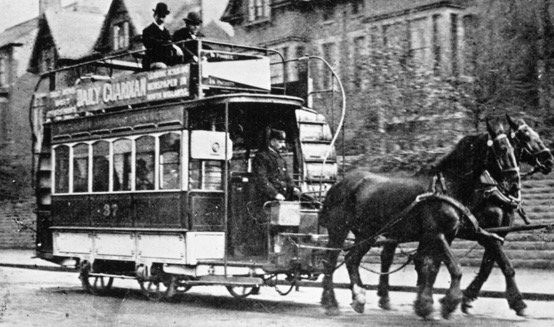
Horsecar No 37 on Mansfield Road, Sherwood — photo taken in the late 1890s, after the corporation take-over, but before they had managed to repaint all the company vehicles they had acquired into full corporation livery. Photo courtesy of the Tramways and Light Railway Society, with thanks to David Voice.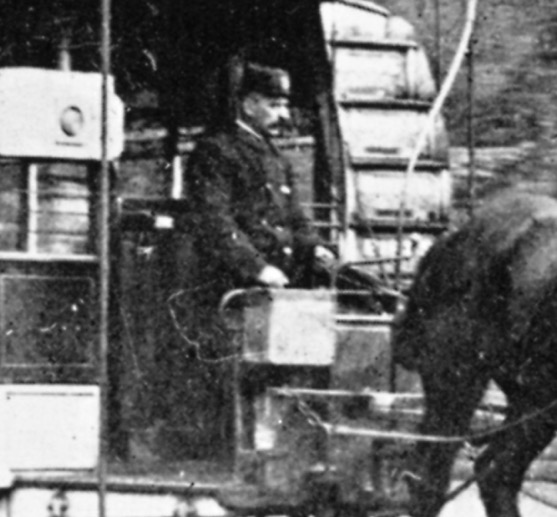
An enlargement of the above photograph showing the driver, who is presumably wearing the same style of kepi cap (and cap badge) issued to staff working the new electric services (see below).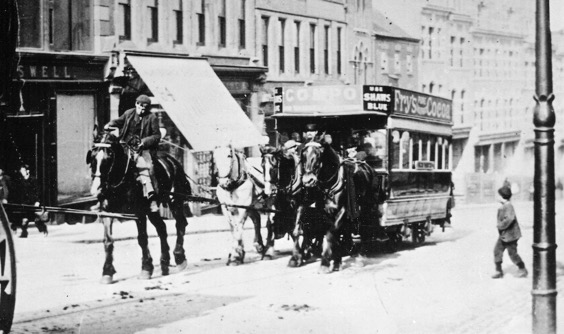
An unidentified Starbuck-built horsecar ascending Derby Hill with assistance from two trace horses — photo undated, but certainly taken in the corporation era. Photo courtesy of the Tramways and Light Railway Society, with thanks to David Voice.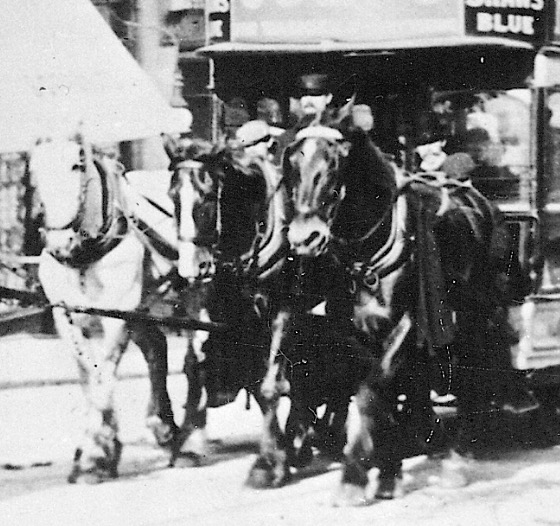
An enlargement of the above photograph showing the driver, who is wearing a kepi-style cap.
Motormen and conductors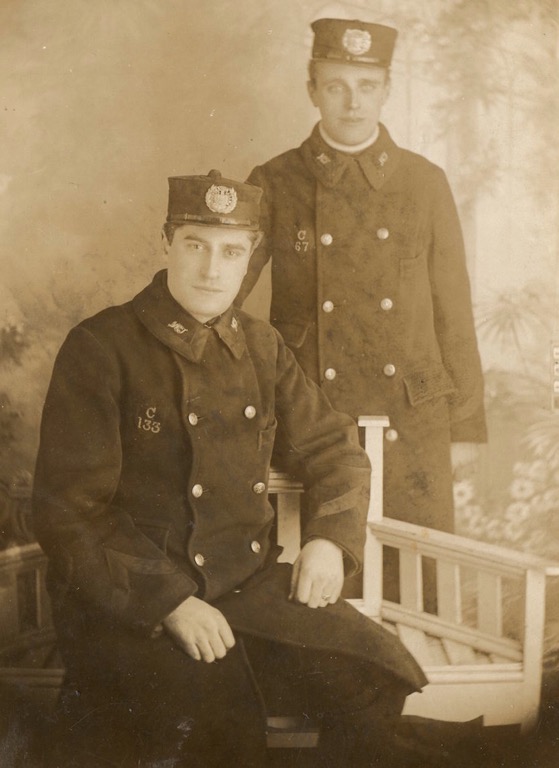
A studio portrait of two NCT conductors (Nos 133 and 76) — photo undated, but probably taken in the late 1890s or the early 1900s. The collars of their greatcoats are edged in a finer material than the main body, with the same material used to embellish the cuffs (with a chevron). Photo courtesy of the John Burford collection.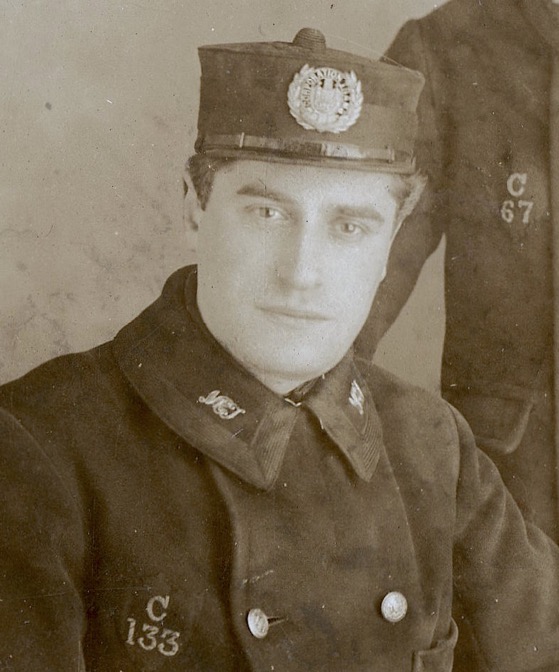
An enlargement of the above photograph showing Conductor No 133 (the number appears to be embroidered and on a shield-shaped cloth background); the collar badges are one-piece brass script initials ('NCT'), and the cap badge is the early pattern with bowmen supporters (see below). 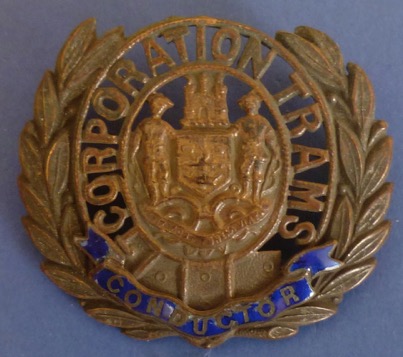
Nottingham Corporation Tramways 'CONDUCTOR' cap badge with bowmen supporters — brass. The bowmen supporters were granted to Nottingham in 1898, and the badge was presumably introduced not long afterwards; although the bowmen were replaced with stags in 1908 (in the official arms), this probably took some time to filter down to new cap badge orders. Author's Collection.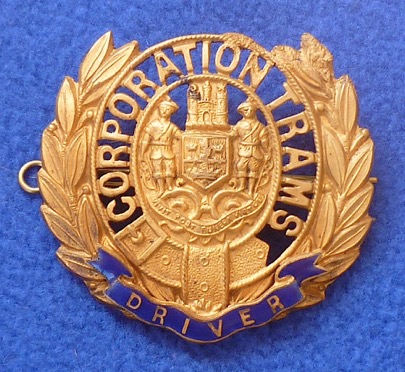
Nottingham Corporation Tramways 'DRIVER' cap badge with bowmen supporters — brass. Unlike its 'CONDUCTOR' equivalent, these badges were probably only worn from 1898 through to the early-to-mid Edwardian era, when they were superseded by script-lettering 'Motorman' grade badges. Author's Collection.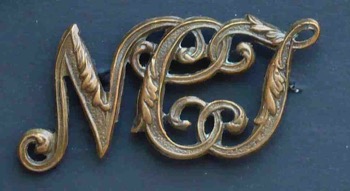
Nottingham Corporation Tramways greatcoat collar badge — brass. These badges were probably worn between 1898 and the early 1930s, when they were, in all likelihood, replaced by chrome issues. Author's Collection.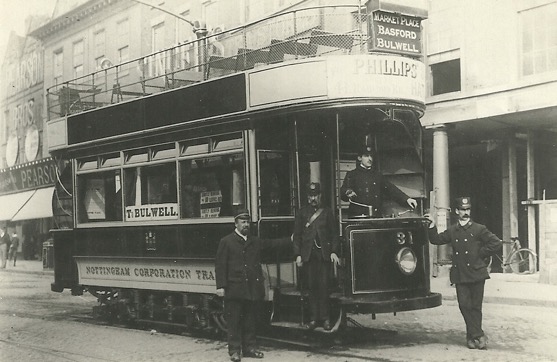
Four tramway employees pose somewhat stiffly for the camera with what appears to be a brand-new Tramcar No 31 (destined for Bulwell), dating the photo to 1901. Photo courtesy of the Stephen Howarth Collection.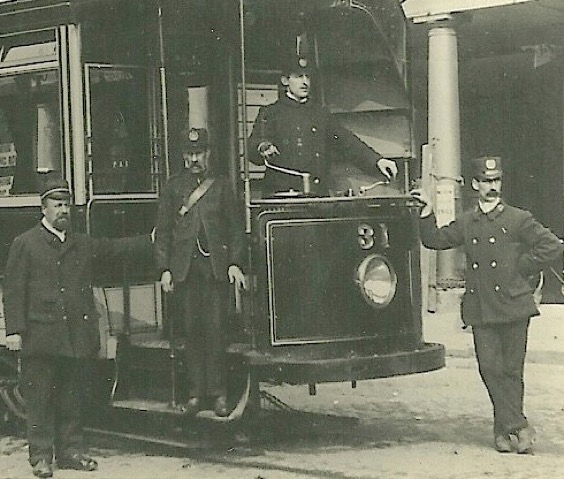
An enlargement of the above photograph. The conductor (on the tramcar steps) is wearing the distinctive single-breasted style of jacket with hidden buttons (or an hook and eye affair), whilst the motorman sports a greatcoat. The grades of the two figures standing in the road are unclear, though they may be traffic inspectors.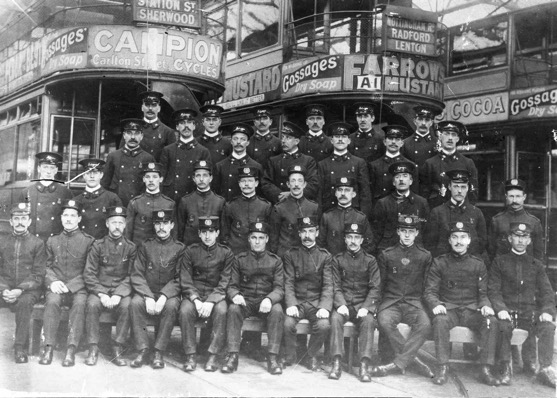
A staff photo taken at one of the corporation depots — photo undated, but probably late Edwardian. Photograph courtesy of the National Tramway Museum.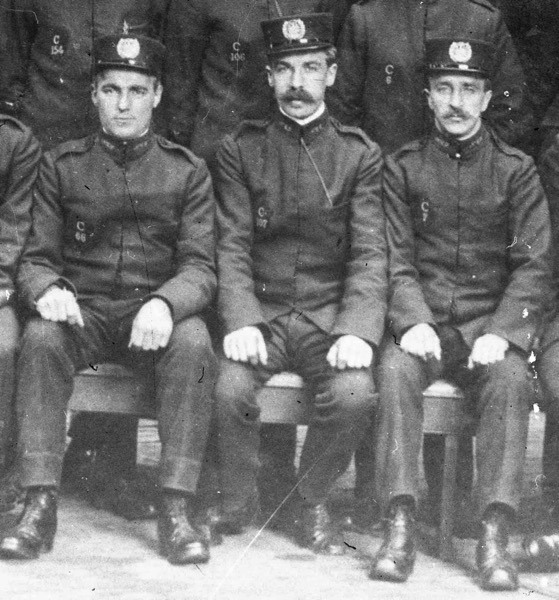
An enlargement of the above photograph showing three of the conductors. All are wearing single-breasted jackets with hidden buttons and kepi-style caps. The subjects' conductor numbers are, from left to right: 'C66', 'C167' and 'C7'. The stand-up collars on the jackets appear to carry embroidered system-initial badges, 'N C T'.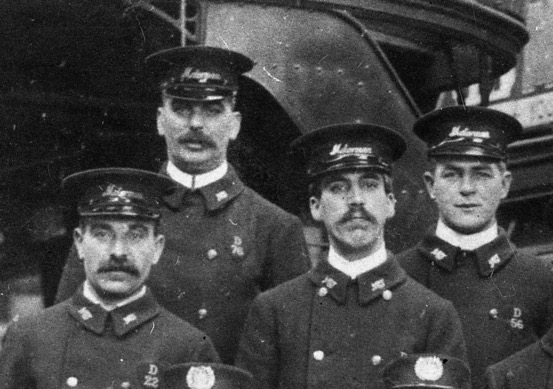
Another blow-up of the above photograph, this time showing four of the motormen. They are all wearing double-breasted greatcoats with their employee designation on their left breast: back left 'D76', back right 'D56', front left 'D22', front right unknown. By this time, the driver grade badges were being worn on the left-breast, rather than the right breast where they had initially been worn. In contrast to conductors, their caps are of the tensioned-crown type; they bear a standard, script-lettering grade badge — 'Motorman' — which would more than likely have been in brass to match the buttons. The collars of the greatcoats bear script-lettering system initials, 'NCT', almost certainly in brass.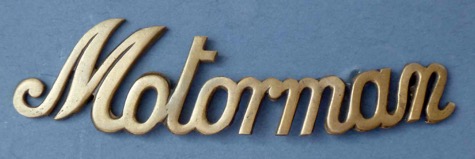
Script-lettering 'Motorman' cap badge, issued to NCT motormen from around the mid-to-late Edwardian era to shortly after the Great War — brass. Author's Collection.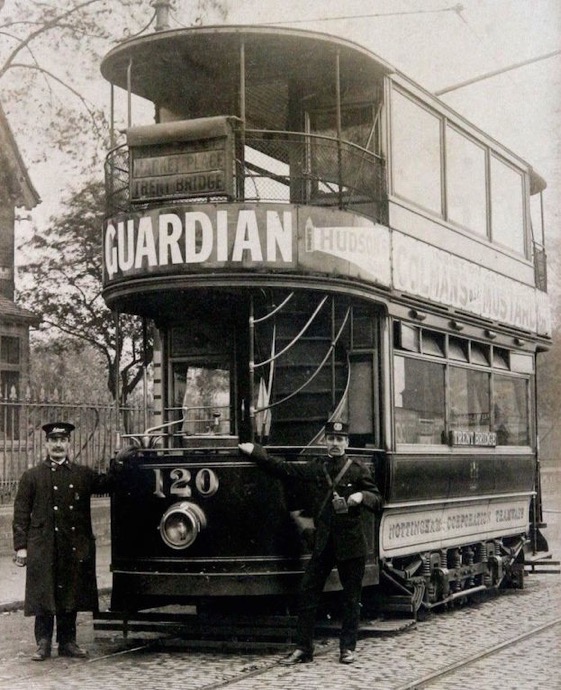
Tramcar No 120 and crew captured at what is possibly the terminus at Mapperley — photograph undated, but given its pristine condition, probably taken in the year it was built, 1908. The motorman is wearing a tensioned-crown peaked cap with a script-lettering grade badge, whilst the conductor has a kepi bearing the large elaborate pattern of cap badge. Source unknown.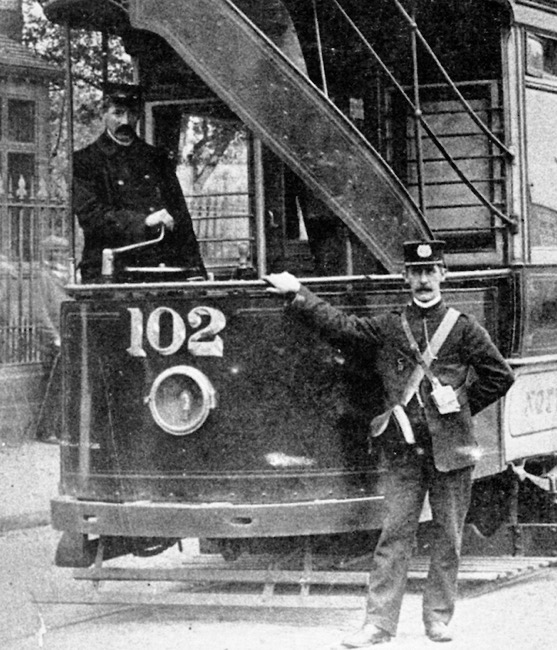
Tramcar No 102 and crew at the same location as the preceding photograph — undated, but as the vehicle is in rebuilt condition with a top cover, and is looking slightly tatty, probably taken in the late-Edwardian era (it has no route number so is certainly no later than 1912, when these were fitted to all cars). The conductor is once again wearing a single-breasted jacket with hidden buttons and a kepi-style cap (with large-pattern cap badge), whereas the motorman is wearing a greatcoat with a tensioned-crown peaked cap. Photo courtesy of the Tramways and Light Railway Society, with thanks to David Voice.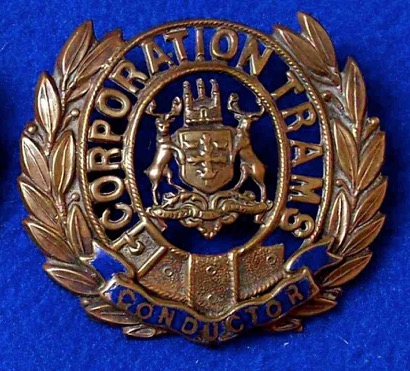
Nottingham Corporation Tramways 'CONDUCTOR' cap badge with stag supporters — brass. Although the stag supporters were granted to Nottingham in 1908, it was probably some considerable time before the corporation ordered new batches of cap badges. Author's Collection.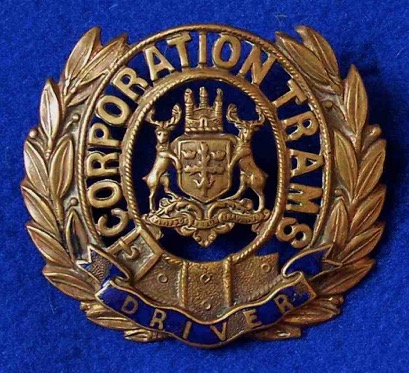
Nottingham Corporation Tramways 'DRIVER' cap badge with stag supporters — brass. Author's Collection.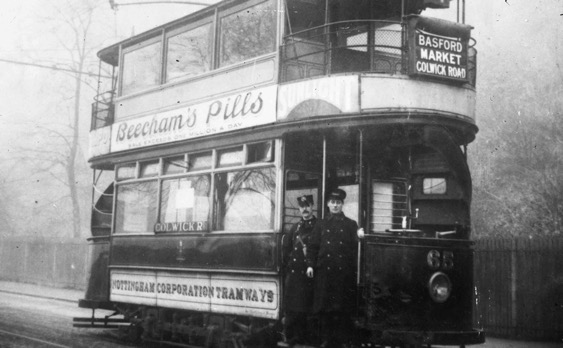
The crew of Tramcar No 65 pose for the camera at what is believed to be Colwick Road — photo undated, but probably taken shortly before the Great War. Photograph courtesy of the National Tramway Museum. 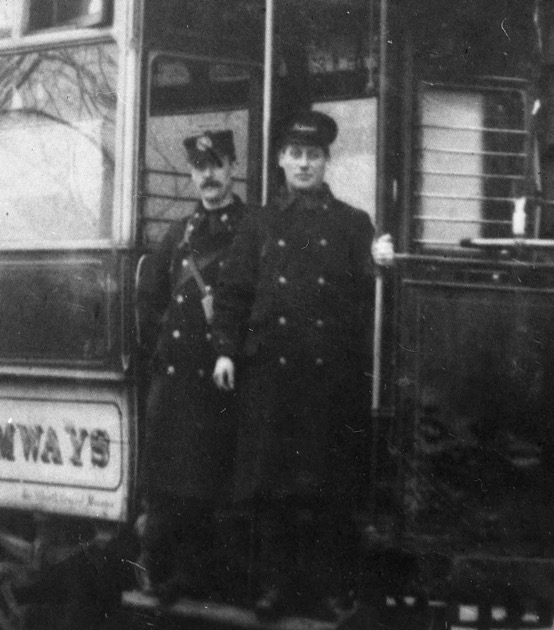
An enlargement of the above photograph showing the crew. This clearly shows the stark contrast in cap badges at this time, the conductor's kepi bearing an elaborate wreath badge and the motorman's tensioned-crown cap a simple, off-the-shelf, script-lettering grade badge. Neither garment appears to bear the cloth grade badges that were previously placed there.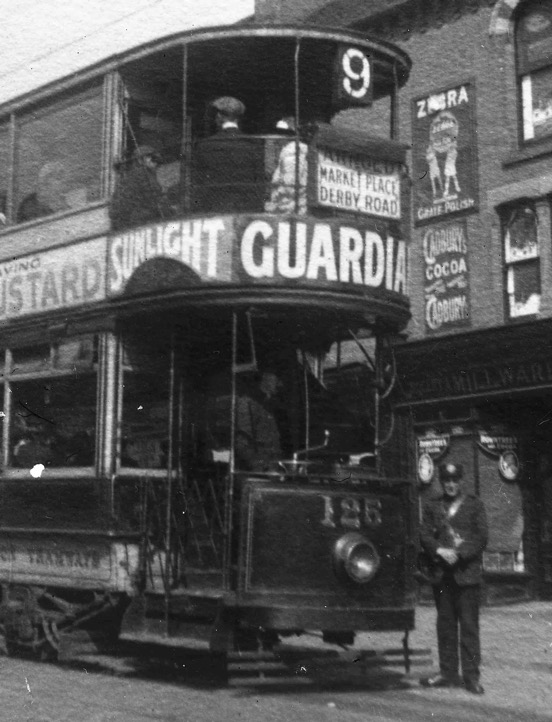
Although far from a good-quality photograph, the image is nevertheless included as it is precisely dated, having been taken on the 25th July 1915 at Sherwood. The conductor is wearing a kepi-style cap. Photograph courtesy of the National Tramway Museum. 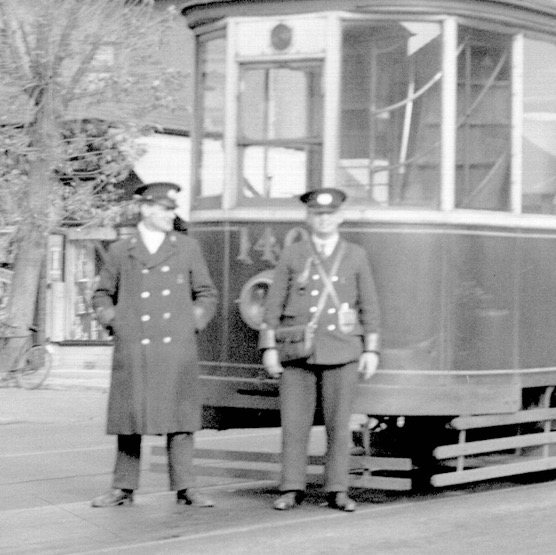
The crew of Tramcar 140 stand at the Mapperley terminus with a service for the Market Place — although the photo is undated, the tramcar bears a 'Route B' indicator, so it can be no earlier than 1933. Both motorman and conductor are clearly wearing large municipal cap badges. Photo by R B Parr, with thanks to the National Tramway Museum. 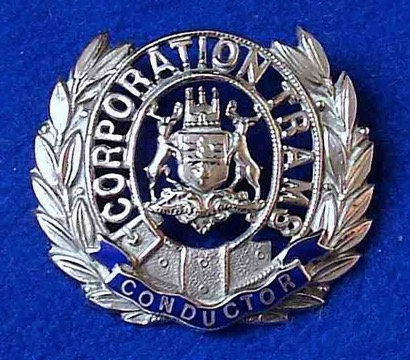
Nottingham Corporation Tramways 'CONDUCTOR' cap badge with stag supporters — chrome. The use of chromium plating as a badge material commenced in the 1930s (see link), so it is likely that these badges saw only very limited use before the tramway system closed in 1936. Author's Collection.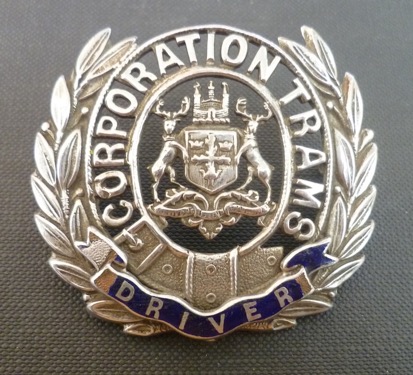
Nottingham Corporation Tramways 'DRIVER' cap badge with stag supporters — chrome. Author's Collection.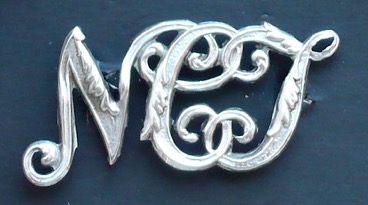
NCT greatcoat collar badge — chrome. This badge probably only saw use very late in the tramway's life. Author's Collection.
Senior staff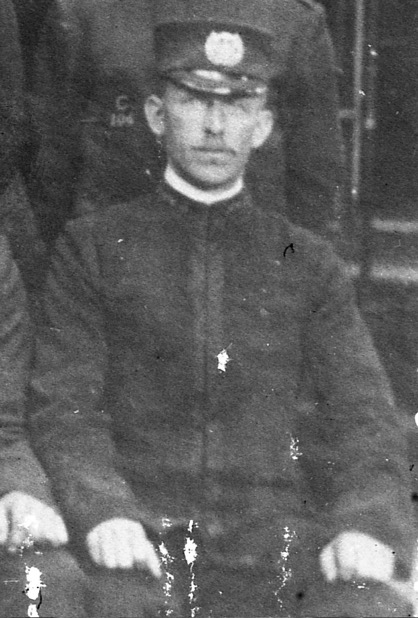
An enlargement of the late-Edwardian staff photograph above showing an inspector, in typical tramway inspector garb with kepi-style cap and prominent cap badge.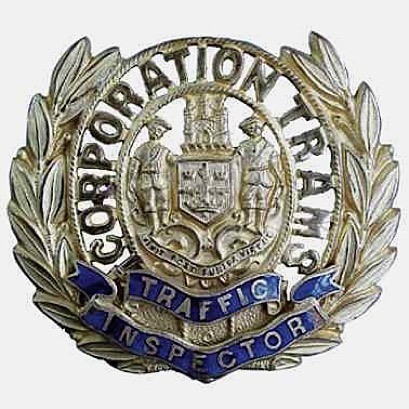
Nottingham Corporation Tramways 'TRAFFIC INSPECTOR' cap badge with bowmen supporters — brass/gilt. Although the bowmen were replaced with stags in 1908 (in the official arms), this probably took some time to filter down to new cap badge orders. With thanks to Talisman Auctions.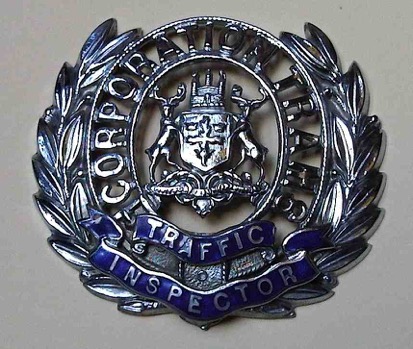
Nottingham Corporation Tramways 'TRAFFIC INSPECTOR' cap badge with stag supporters — chrome. It is likely that these badges saw only very limited use before the tramway system closed.
Female staff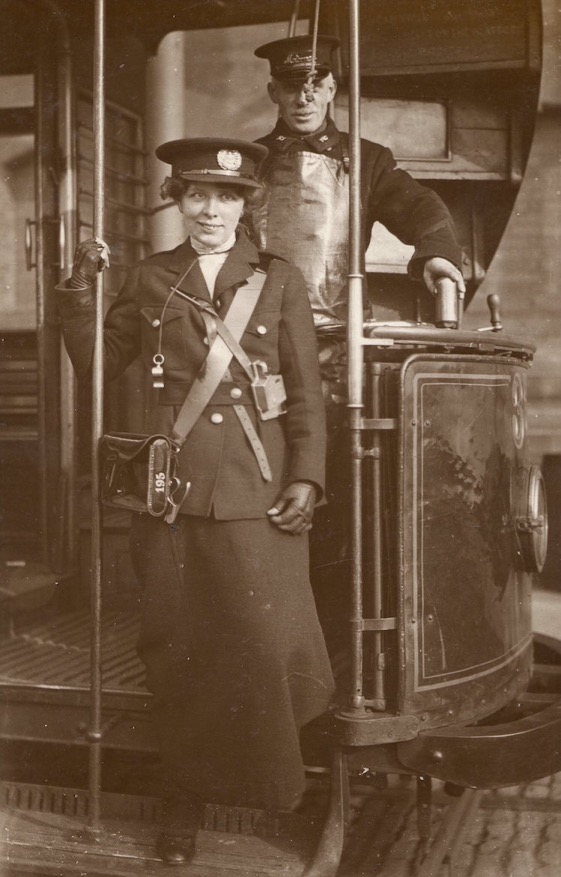
A well-known shot of a Great War NCT tram conductress and a motorman. The pristine condition of the uniform strongly suggests that this was a staged photograph, probably taken to mark the first conductresses employed. The large-crown caps do not appear to have lasted long, as they are not seen in later photographs. The motorman is wearing a script-lettering 'Motorman' cap badge, along with 'NCT' script collar initials. With thanks to the Richard Rosa Collection.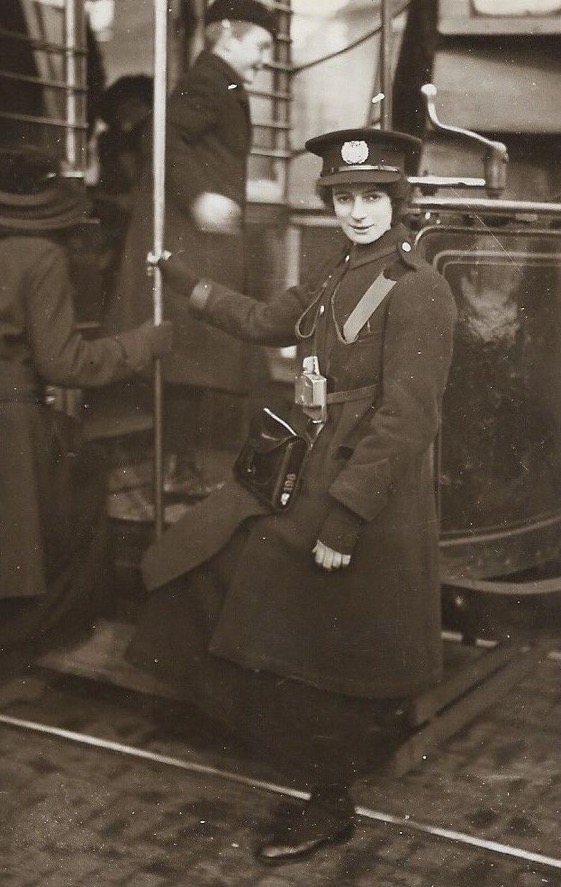
Another commercial postcard of a Great War Nottingham tram conductress, but this time wearing a single-breasted top coat. Her cash bag number is 196, which is only one digit higher than the bag in the previous photo (195), suggesting that the photos may have been staged with two new conductresses, probably the first to be employed. Image in the public domain.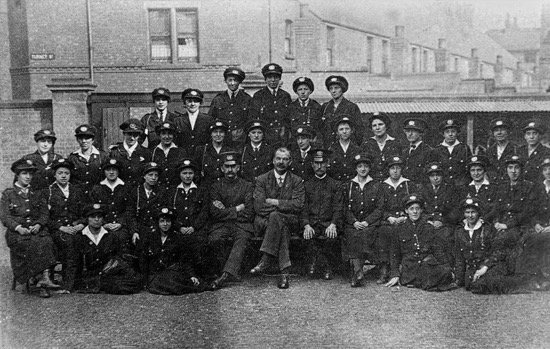
A group of tram conductresses gathered at Trent Bridge depot — photo undated, but certainly taken during the Great War. Photo courtesy of the Stephen Howarth Collection.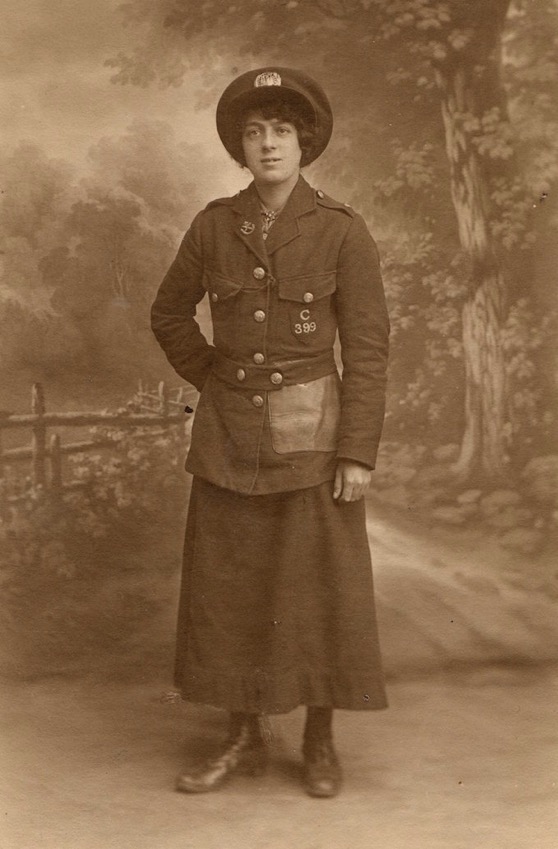
A lovely studio portrait of an NCT Great War tram conductress (No 399). The leather patch was presumably to prevent abrasion from the ticket punch, which would have hung there. Author's Collection.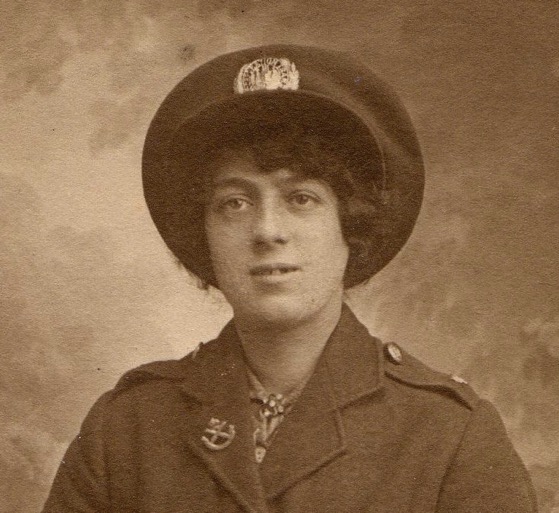
An enlargement of the above photograph showing the cap badge, which is of the bowmen type, even though the bowmen supporters had been replaced by stags on the official Nottingham coat of arms some ten years previously. The baggy peaked cap is of a type that would come to be known as 'motor caps'. The sweetheart badge on the subject's right lapel is based on a Machine Gun Corps badge. The photo nicely shows the large crown (top) to the cap.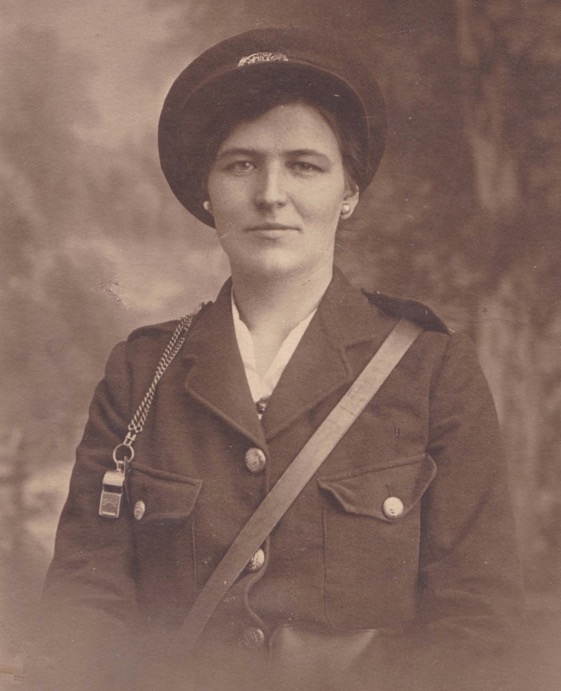
Another photograph of an NCT Great War conductress, possibly taken in the same studio as the shot above. Photograph by Hunt & Fryer, 36 Goldsmith St., Nottingham; with thanks to the Geoff Caulton Collection.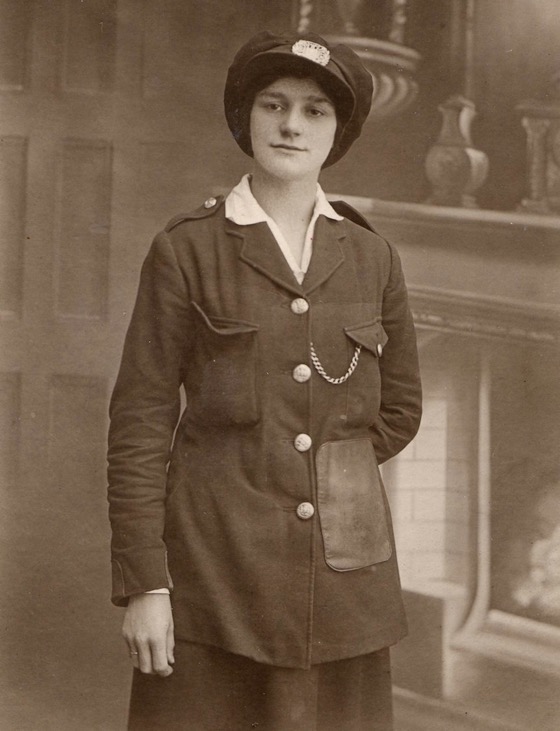
A Great War Nottingham Corporation Tramways conductress, curiously without a belt or an employee number. Author's Collection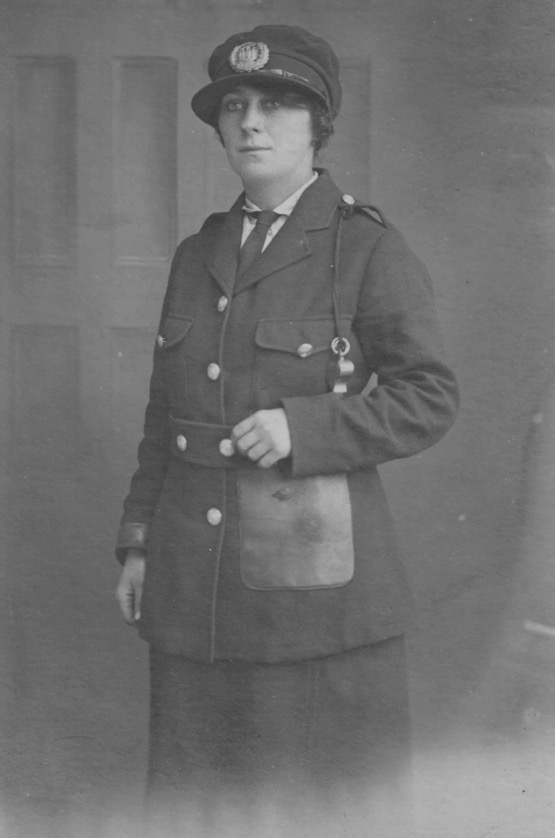
A Great War NCT conductress, who according to the rear of the postcard, was very probably called Eva. She is wearing a much smarter jacket than the lady in the previous photograph, without a number patch, but with a waist belt. The cap badge is once again the early pattern with bowmen supporters. Like several of the preceding photographs, it was taken in the studios of Hunt & Fryer, 36 Goldsmith St., Nottingham. Author's Collection.